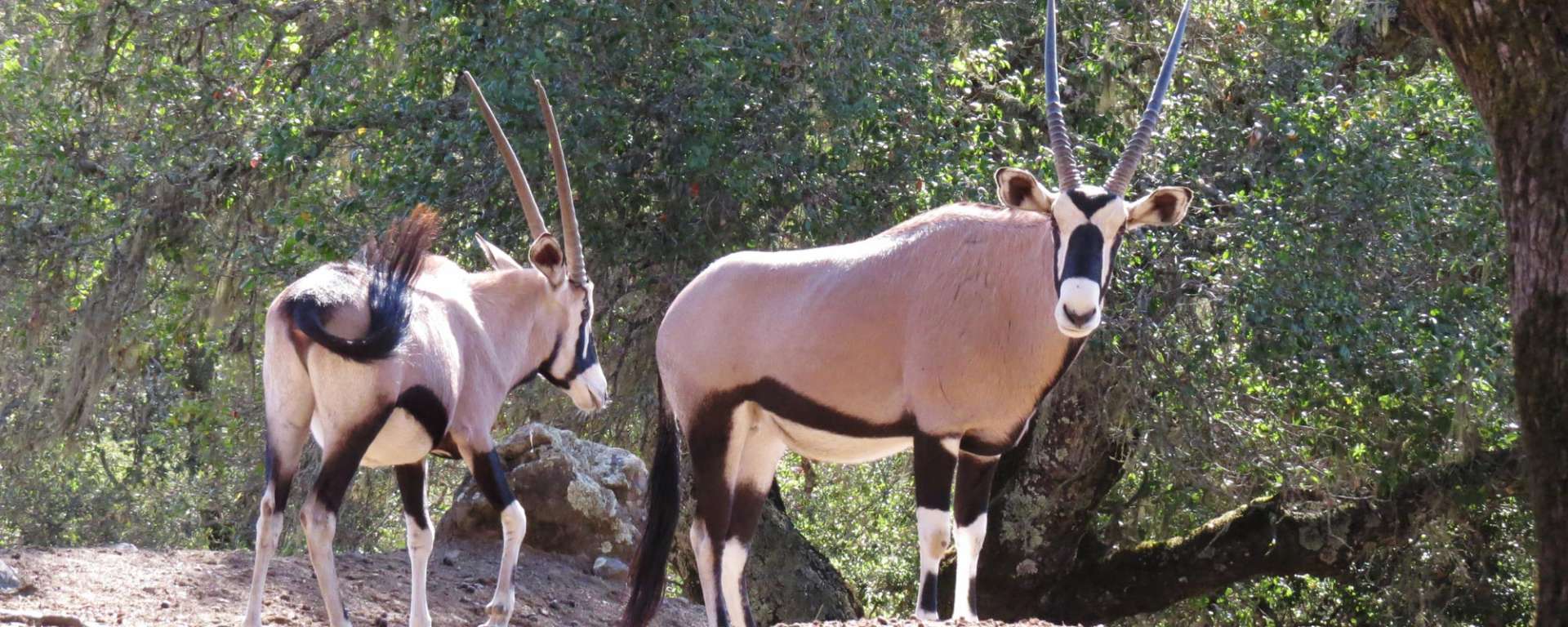Description
Large beautiful antelope, gemsbok have distinctive black and white markings on their face and body. Males and females are very similar in appearance, having long, straight, spear-like horns that can reach 32-36 in (81-91 cm) in length. The horns of the female are often shorter and more slender than those of males.
Classification
- Class
- Mammalia
- Order
- Cetartiodactyla
- Family
- Bovidae
- Genus
- Oryx
- Species
- O. gazella
- Conservation Status
- Least Concern
Key Facts
- Height
- 3.7-4 ft (~115-125 cm)
- Weight
- 396-530 lb (~180-240 kg)
The IUCN Red List describes Oryx gazella as a species of Least Concern. Gemsbok are numerous and widespread with a population of around 275,000 individuals. Though the numbers do not indicate a threatened population, large declines in several areas have resulted from habitat loss, climate change, agriculture and livestock grazing.
Social Life
Gemsbok are typically gregarious and nomadic in nature, forming groups of 12-20 animals. In times of rain or migration herd sizes can swell to 50-200 individuals. Herds have a distinct hierarchy with the dominant male at the top, followed by the dominant female. Other males will stay with the herd but are submissive to the dominant male. While on the move the dominant male will typically be found at the rear of the herd and the dominant female at the front.
Habitat and Range
Gemsbok are adapted to many areas where most large mammals are unable to survive. They inhabit simi-arid and arid bushland and grassland of southern Africa, specifically the Kalahari and Karoo deserts. They prefer stony plains with at least limited water access, but are also found in dunes and rocky mountainous areas. Gemsbok have been introduced into Mexico, as well as the southwestern United States where they are free roaming.
Diet
Gemsbok are generally grazers that feed mostly on sparse dry desert grasses but will browse during droughts or when grass is not available. They will also dig for roots, tubers, cucumbers and melons using their horns. Gemsboks feed early in the morning, late in the afternoon and on moonlit nights when the water content of plants are at their highest. They drink water when available but can survive for weeks without it.
Lifespan
The average lifespan of gemsbok is approximately 18 years in the wild, and 20 in captivity.
Predators
Main predators include lions, leopards, painted dogs and spotted hyenas. Cheetahs and jackals pose additional threats to young gemsbok. Their primary response to predation is flight, despite impressive weaponry.
Reproduction
Sexual maturity: Male: 1.5-2 years, Female: 1.5-2 years
Mating Season: Year-round, dependent on water availability
Birth Season: Year-round
Gestation: 8.5 months
No. of Young: 1-2
- Information
-
Description
Large beautiful antelope, gemsbok have distinctive black and white markings on their face and body. Males and females are very similar in appearance, having long, straight, spear-like horns that can reach 32-36 in (81-91 cm) in length. The horns of the female are often shorter and more slender than those of males.
Classification
- Class
- Mammalia
- Order
- Cetartiodactyla
- Family
- Bovidae
- Genus
- Oryx
- Species
- O. gazella
- Conservation Status
- Least Concern
Key Facts
- Height
- 3.7-4 ft (~115-125 cm)
- Weight
- 396-530 lb (~180-240 kg)
- Conservation
The IUCN Red List describes Oryx gazella as a species of Least Concern. Gemsbok are numerous and widespread with a population of around 275,000 individuals. Though the numbers do not indicate a threatened population, large declines in several areas have resulted from habitat loss, climate change, agriculture and livestock grazing.
- Lifestyle
Social Life
Gemsbok are typically gregarious and nomadic in nature, forming groups of 12-20 animals. In times of rain or migration herd sizes can swell to 50-200 individuals. Herds have a distinct hierarchy with the dominant male at the top, followed by the dominant female. Other males will stay with the herd but are submissive to the dominant male. While on the move the dominant male will typically be found at the rear of the herd and the dominant female at the front.Habitat and Range
Gemsbok are adapted to many areas where most large mammals are unable to survive. They inhabit simi-arid and arid bushland and grassland of southern Africa, specifically the Kalahari and Karoo deserts. They prefer stony plains with at least limited water access, but are also found in dunes and rocky mountainous areas. Gemsbok have been introduced into Mexico, as well as the southwestern United States where they are free roaming.Diet
Gemsbok are generally grazers that feed mostly on sparse dry desert grasses but will browse during droughts or when grass is not available. They will also dig for roots, tubers, cucumbers and melons using their horns. Gemsboks feed early in the morning, late in the afternoon and on moonlit nights when the water content of plants are at their highest. They drink water when available but can survive for weeks without it.Lifespan
The average lifespan of gemsbok is approximately 18 years in the wild, and 20 in captivity.Predators
Main predators include lions, leopards, painted dogs and spotted hyenas. Cheetahs and jackals pose additional threats to young gemsbok. Their primary response to predation is flight, despite impressive weaponry.Reproduction
Sexual maturity: Male: 1.5-2 years, Female: 1.5-2 years
Mating Season: Year-round, dependent on water availability
Birth Season: Year-round
Gestation: 8.5 months
No. of Young: 1-2

